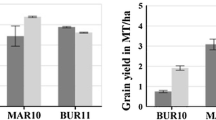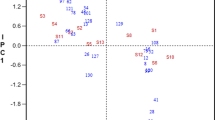Abstract
Breeding maize for use as a biogas substrate (biogas maize) has recently gained considerable importance. To optimize hybrid breeding programs, information about line per se performance (LP) of inbreds and its relation to their general combining ability (GCA) is required. The objectives of our research were to (1) estimate variance components and heritability of LP for agronomic and quality traits relevant to biogas production, (2) study correlations among traits as well as between LP and GCA, and (3) discuss implications for breeding of biogas maize. We evaluated 285 diverse dent maize inbred lines in six environments. Data were recorded on agronomic and quality traits, including dry matter yield (DMY), methane fermentation yield (MFY), and their product, methane yield (MY), as the main target trait. In agreement with observations made for GCA in a companion study, variation in MY was mainly determined by DMY. MFY, which showed moderate correlation with lignin but only weak correlation with starch, revealed only low genotypic variation. Thus, our results favor selection of genotypes with high DMY and less focus on ear proportion for biogas maize. Genotypic correlations between LP and GCA [r g (LP, GCA)] were highest (≥0.94) for maturity traits (days to silking, dry matter concentration) and moderate (≥0.65) for DMY and MY. Multistage selection is recommended. Selection for GCA of maturity traits, plant height, and to some extent also quality traits and DMY on the level of LP looks promising.
Similar content being viewed by others
References
Argillier O, Barrière Y, Hébert Y (1995) Genetic variation and selection criterion for digestibility traits of forage maize. Euphytica 82:175–184
Argillier O, Méchin V, Barrière Y (2000) Inbred line evaluation and breeding for digestibility-related traits in forage maize. Crop Sci 40:1596–1600
Barrière Y, Hébert Y, Julier B, Young E, Furstoss V (1993) Genetic variation for silage and NIRS traits in an half-diallel design of 21 inbred lines of maize. Maydica 38:7–13
Buckler ES, Holland JB, Bradbury PJ, Acharya CB, Brown PJ, Browne C et al (2009) The genetic architecture of maize flowering time. Science 325:714–718
Butler DG, Cullis BR, Gilmour AR, Gogel BJ (2007) Analysis of mixed models for S language environments. ASReml-R reference manual. 2.0
Eder B, Eder J, Papst C, Darnhofer B, Mukengele M, Heuwinkel H, Oechnser H (2009) Welcher Maissortentyp zur Biogaserzeugung? In: Internationale Wissenschaftstagung Biogas Science, Bayerische Landesanstalt für Landwirtschaft (LfL), pp 57–72
Falconer DS, Mackay TF (1996) Introduction to quantitative genetics. Longman Group Limited, Harlow
Gerin PA, Vliegen F, Jossart JM (2008) Energy and CO2 balance of maize and grass as energy crops for anaerobic digestion. Bioresour Technol 99:2620–2627
Gilmour AR, Gogel BJ, Cullis BR, Thompson R (2006) ASReml User Guide Release 2.0. VSN International Ltd, Hemel Hempstead, HP1 1ES, UK
Grieder C, Mittweg G, Dhillon BS, Montes JM, Orsini E, Melchinger AE (2011a) Determination of methane fermentation yield and its kinetics by near infrared spectrsocopy and chemical composition in maize. JNIRS (in press)
Grieder C, Schipprack W, Dhillon BS, Melchinger AE (2011b) Breeding maize as biogas substrate in Central Europe: I. Quantitative-genetic parameters for testcross performance. Theor Appl Genet (this issue). doi:10.1007/s00122-011-1761-y
Gurrath PA, Dhillon BS, Pollmer WG, Klein D, Zimmer E (1991) Utility of inbred line evaluation in hybrid breeding for yield and stover digestibility in forage maize. Maydica 36:65–68
Hallauer AR (1990) Methods used in developing maize inbreds. Maydica 35:1–16
Hallauer AR, Miranda JB (1988) Quantitative genetics in maize breeding, 2nd edn. Iowa State University Press, Ames
Holland JB, Nyquist WE, Cervantes-Martínez CT (2003) Estimating and interpreting heritability for plant breeding: an update. Plant Breed Rev 22:9–111
Kreps RC, Gumber RK, Schulz B, Klein D, Melchinger AE (1998) Genetic variation in testcrosses of European maize inbreds for resistance to the European corn borer and relations to line per se performance. Plant Breed 117:319–327
Lübberstedt T, Melchinger AE, Schön CC, Utz HF, Klein D (1997) QTL mapping in testcrosses of European flint lines of maize: I. Comparison of different testers for forage yield traits. Crop Sci 37:921–931
Mihaljevic R, Schön CC, Utz HF, Melchinger AE (2005) Correlations and QTL correspondence between line per se and testcross performance for agronomic traits in four populations of European maize. Crop Sci 45:114–122
Montes JM, Paul C, Melchinger AE (2007) Determination of chemical composition and nutritional attributes of silage corn hybrids by near-infrared spectroscopy on chopper: evaluation of traits, sample presentation systems and calibration transferability. Plant Breed 126:521–526
Patterson HD, Williams ER (1976) A new class of resolvable incomplete block designs. Biometrika 63:83–92
Piepho HP, Büchse A, Truberg B (2006a) On the use of multiple lattice designs and α-designs in plant breeding trials. Plant Breed 125:523–528
Piepho HP, Williams ER, Fleck M (2006b) A note on the analysis of designed experiments with complex treatment structure. Hort Science 41:446–452
Prigge V, Melchinger AE (2011) Production of haploids and doubled haploids in maize. In: Loyola-Vargas VM, Ochoa-Alejo N (eds) Plant cell culture protocols, 3rd edn. Humana Press, Springer, Totowa
R Development Core Team (2009) R: a language and environment for statistical computing. 2.9
Rawlings JO, Thompson DL (1962) Performance level as criterion for the choice of maize testers. Crop Sci 2:217–220
Schmidt W (2003) Hybridmaiszüchtung bei der KWS SAAT AG. Bericht über die 54. Tagung 2003 der Vereinigung der Pflanzenzüchter und Saatgutkaufleute Österreichs, BAL Gumpenstein, pp 1–6
Seitz G, Geiger HH, Schmidt GA, Melchinger AE (1992) Genotypic correlations in forage maize II. Relationship between inbred line and testcross performance. Maydica 37:101–105
Smith OS (1986) Covariance between line per se and testcross performance. Crop Sci 26:540–543
Strigens A, Grieder C, Haussmann B, Melchinger AE (2011) Genetic variation among inbred lines and testcrosses of maize for early growth parameters and their relationship to final dry matter yield. Crop Sci (in press)
Acknowledgments
We thank P. Tillmann for providing NIRS calibrations, F. Utz and H.P. Piepho for statistical consultancy, I. Lewandowski for suggestions on the manuscript, and F. Mauch, J. Jesse, H. Poeschel, R. Lutz, T. Schmidt, and R. Volkhausen for contribution to the conduct of the field experiments. This work was financed by the Bundesministerium für Bildung und Forschung (BMBF) within the framework of the projects GABI-Energy (FK 0315045B) and Cornfed (FK 03115461A).
Author information
Authors and Affiliations
Corresponding author
Additional information
Communicated by T. Luebberstedt.
Electronic supplementary material
Below is the link to the electronic supplementary material.
Rights and permissions
About this article
Cite this article
Grieder, C., Dhillon, B.S., Schipprack, W. et al. Breeding maize as biogas substrate in Central Europe: II. Quantitative-genetic parameters for inbred lines and correlations with testcross performance. Theor Appl Genet 124, 981–988 (2012). https://doi.org/10.1007/s00122-011-1762-x
Received:
Accepted:
Published:
Issue Date:
DOI: https://doi.org/10.1007/s00122-011-1762-x




